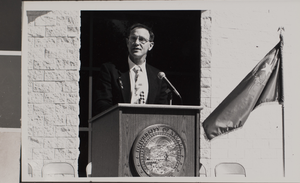Search the Special Collections and Archives Portal
Search Results
Jay Sarno Photograph Collection
Identifier
Abstract
The Jay Sarno Photograph Collection (1947-1983) contains photographs from hotel and casino developer Jay Sarno. The photographs primarily depict Sarno and his family. The photographs also depict some of Sarno's development projects, including Circus Circus, Caesars Palace, and the Grandissimo. The photographs depict construction of the hotels, events, and famous figures.
Archival Collection
Florence McClure Photograph Collection
Identifier
Abstract
The Florence McClure Photograph Collection (approximately 1985-1997) consists of color photographic prints. Images show McClure and members of the Las Vegas, Nevada Community Action Against Rape (CAAR) organization that she co-founded with Sandi Petta in 1973. Also included are images of Nevada public figures and several travel images from China.
Archival Collection
Evan Renglehoff Collection of Punchboards
Identifier
Abstract
The Evan "Ding" Renglehoff Collection of Punchboards (1930s-1940s) is comprised of forty-two assorted punchboards with identifying documentation.
Archival Collection
Marko Dobro Photograph Collection
Identifier
Abstract
The Marco Dobro Photograph Collection, approximately 1910 to 1960, contains black-and-white photographic prints, negatives, slides, and postcards. Images consist primarily of locations in and around Tonopah, Goldfield, and Wells, Nevada, including Dobro's Nevada Cafe in Tonopah. Many images feature Dobro with friends and associates. A small number of images show locations in Southern California.
Archival Collection
Paul J. Richert Photograph Collection
Identifier
Abstract
The Paul J. Richert Photograph Collection (approximately 1950-1951) consists of black-and-white photographic prints and negatives depicting the swimming pools at the Desert Inn and Flamingo Hotel & Casino in Las Vegas, Nevada. Also included is an image of the Las Vegas High School Rhythmettes dance group and an image of the El Rancho Hotel and Casino in Las Vegas.
Archival Collection
Tonopah-Goldfield Mining Photograph Collection
Identifier
Abstract
The Tonopah-Goldfield Mining Photograph Collection depicts mining activities in the mining towns of Tonopah and Goldfield in Esmeralda County, Nevada from approximately 1901 to 1920. The photographs primarily depict mines, miners, mills, construction, ore, and workers transporting ore. The photographs also depict events and people in Tonopah and Goldfield, including parades, celebrations, banquets, children, Native Americans, and prominent buildings.
Archival Collection

Photograph of an unidentified speaker at the groundbreaking ceremony, University of Nevada, Las Vegas, circa 1991-1992
Date
Archival Collection
Description
Image
Elbert Edwards Photograph Collection
Identifier
Abstract
The Elbert Edwards Photograph Collection contains photographs of Nevada from 1852 to 1991. The collection has a wide variety of photographs, including: white pioneers and settlers; early Nevada towns; Nevada politicians; early Las Vegas landmarks; Boulder City schools; petroglyphs from Nevada's indigenous populations; Lost City and Lake Mead; railroads; the Hoover Dam (Boulder Dam); Basic Magnesium Inc. in Henderson, Nevada; geographical features; the Edwards family; and photographs of Elbert Edwards's participation in the Las Vegas Education Association and the Rotary Club.
Archival Collection
Wayne Cronister Photograph Collection
Identifier
Abstract
The Wayne Cronister Photograph Collection depicts towns in Southern Nevada from 1905 to 1950. The photographs primarily depict Fremont Street in Las Vegas, Nevada and the construction of the Hoover (Boulder) Dam on the Colorado River. The photographs also include the Union Pacific Railroad Depot in Las Vegas, Nevada, the abandoned town of Rhyolite, Nevada, and a mining camp in El Dorado Canyon.
Archival Collection
William White Postcard Collection
Identifier
Abstract
The William White Postcard Collection (approximately 1930-1940) consists of three postcards depicting the Hoover Dam (Boulder Dam) on the border of Nevada and Arizona. One postcard showcases Oskar J. W. Hansen’s “Figures of the Republic” sculptures near the Hoover Dam. Another postcard displays an interior view of the visitor’s gallery at the Hoover Dam. The final postcard depicts the Hoover Dam at sunset.
Archival Collection
